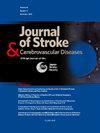The value of quantitative dual-energy CT parameters in predicting delayed haemorrhage after thrombectomy in acute ischaemic stroke
IF 1.8
4区 医学
Q3 NEUROSCIENCES
Journal of Stroke & Cerebrovascular Diseases
Pub Date : 2024-10-10
DOI:10.1016/j.jstrokecerebrovasdis.2024.108083
引用次数: 0
Abstract
Objective
This study investigates the predictive value of dual-energy CT Rho/Z quantitative parameters for delayed hemorrhage post-thrombectomy in patients with acute ischemic stroke
Materials and Methods
A retrospective analysis was conducted on 80 patients who underwent dual-energy CT after thrombectomy for acute ischemic stroke. Patients were divided into delayed hemorrhage/no delayed hemorrhage, symptomatic intracranial hemorrhage/asymptomatic intracranial hemorrhage and cerebral parenchymal hematoma/no cerebral parenchymal hematoma groups
Results
The quantitative parameters significantly associated with delayed hemorrhage are DEI and Zeff (p < 0.001), with the optimal cutoff values for DEI and Zeff being 0.045 and 9.355, respectively. The quantitative parameters significantly associated with symptomatic intracranial hemorrhage are DEI and Zeff (p < 0.001), with the optimal cutoff values being 0.064 and 9.422, respectively. The parameters significantly associated with cerebral parenchymal hematoma are DEI and Zeff (p < 0.001), with the optimal cutoff values for DEI and Zeff being 0.058 and 9.09, respectively
Conclusion
The DEI and Zeff parameters derived from dual-energy CT Rho/Z analysis are valuable in predicting delayed hemorrhage, symptomatic intracranial hemorrhage, and cerebral parenchymal hematoma in patients with acute ischemic stroke following thrombectomy.
定量双能 CT 参数在预测急性缺血性脑卒中血栓切除术后延迟出血中的价值。
目的本研究探讨双能 CT Rho/Z 定量参数对急性缺血性脑卒中患者血栓切除术后延迟出血的预测价值 材料与方法:对 80 例急性缺血性脑卒中血栓切除术后接受双能 CT 检查的患者进行回顾性分析。将患者分为延迟出血组/无延迟出血组、有症状颅内出血组/无症状颅内出血组和脑实质血肿组/无脑实质血肿组 结果:与延迟出血显著相关的定量参数为 DEI 和 Zeff(P < 0.001),DEI 和 Zeff 的最佳临界值分别为 0.045 和 9.355。与症状性颅内出血明显相关的定量参数是 DEI 和 Zeff(p < 0.001),最佳临界值分别为 0.064 和 9.422。与脑实质血肿明显相关的参数是 DEI 和 Zeff(p < 0.001),DEI 和 Zeff 的最佳临界值分别为 0.058 和 9.09 结论:通过双能 CT Rho/Z 分析得出的 DEI 和 Zeff 参数对预测急性缺血性卒中患者血栓切除术后的延迟出血、症状性颅内出血和脑实质血肿很有价值。
本文章由计算机程序翻译,如有差异,请以英文原文为准。
求助全文
约1分钟内获得全文
求助全文
来源期刊

Journal of Stroke & Cerebrovascular Diseases
Medicine-Surgery
CiteScore
5.00
自引率
4.00%
发文量
583
审稿时长
62 days
期刊介绍:
The Journal of Stroke & Cerebrovascular Diseases publishes original papers on basic and clinical science related to the fields of stroke and cerebrovascular diseases. The Journal also features review articles, controversies, methods and technical notes, selected case reports and other original articles of special nature. Its editorial mission is to focus on prevention and repair of cerebrovascular disease. Clinical papers emphasize medical and surgical aspects of stroke, clinical trials and design, epidemiology, stroke care delivery systems and outcomes, imaging sciences and rehabilitation of stroke. The Journal will be of special interest to specialists involved in caring for patients with cerebrovascular disease, including neurologists, neurosurgeons and cardiologists.
 求助内容:
求助内容: 应助结果提醒方式:
应助结果提醒方式:


